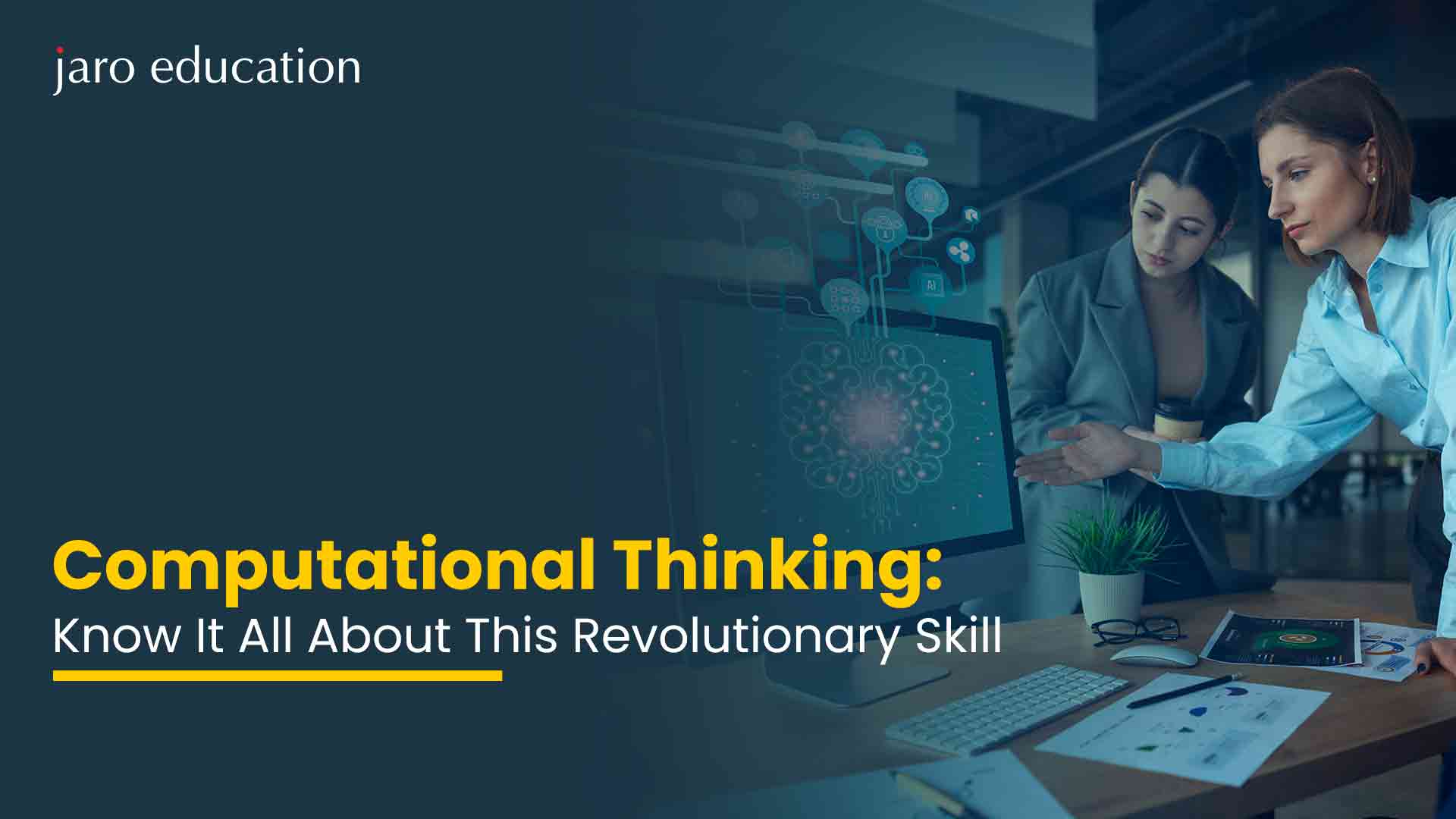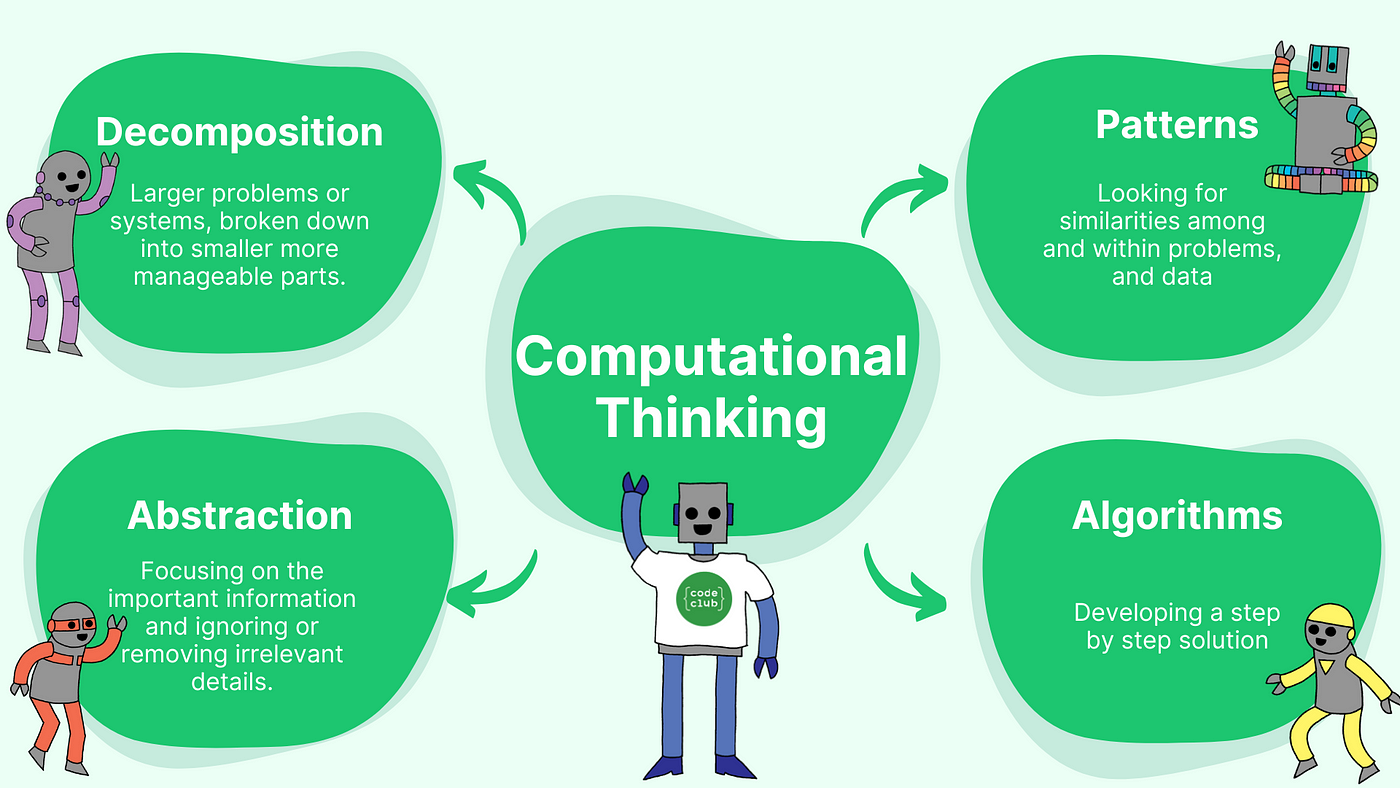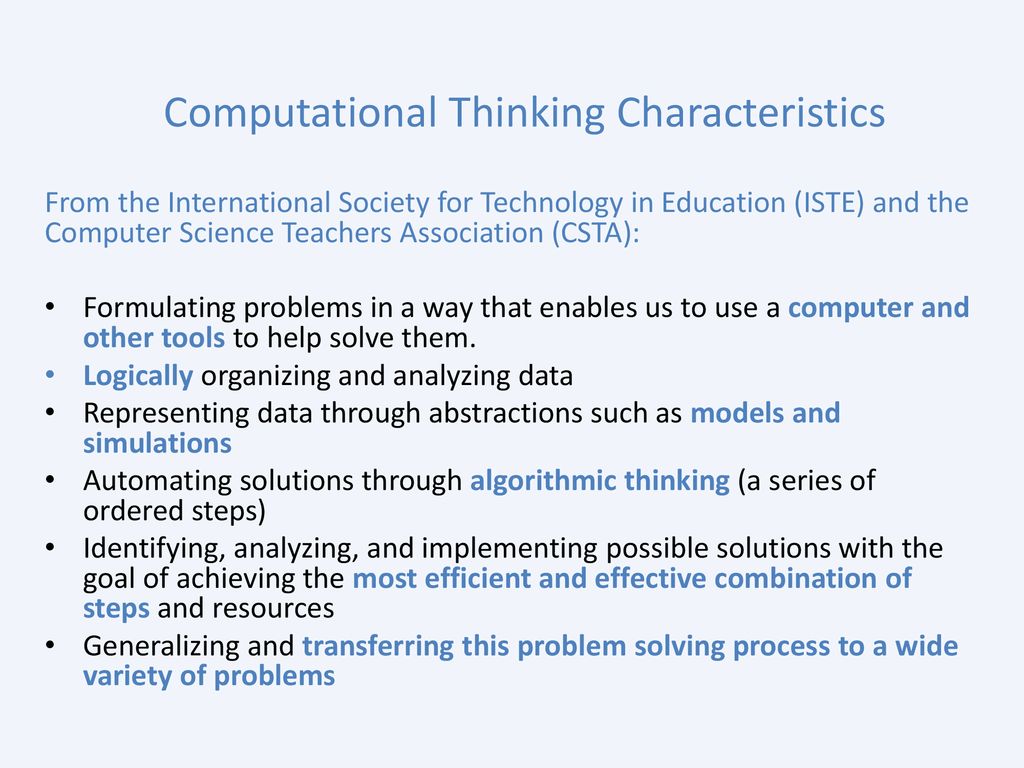Computational Thinking: Know It All About This Revolutionary Skill
Table of Contents

- jaro education
- 10, May 2024
- 10:56 am
There are different terms such as computer science, computational thinking, and programming, each with a unique focus. While computer science focuses on an academic discipline, computational thinking is more focused on problem-solving, integrating skills from computer science into everyday scenarios. The programming, on the other hand, includes the creation of instructions for computers.
But the methods of computer thought go beyond coding. This is the use of IT skills in various problems, actual situations, and public research mathematics for creative and effective solutions to the problem. In this article, you can fully understand how to think of your computer, its components, and how it is important in the new digital age.
Define Computational Thinking
Computational thinking practices (CT) involve the cognitive processes used to define problems so that their solutions can be described as computer-based steps and algorithms.
- In education, CT includes problem-solving methods where problems and solutions are expressed in ways that a computer can understand and execute.
- This includes automating tasks and using computers to explore, analyze, and understand both natural and artificial processes.
- Computational thinking skills involve a set of methods to solve complex problems, help learn in different subjects, and is crucial for thriving in today’s digital world.
- When we talk about computing, computer science, computational thinking, and programming, we use many terms.
- Computational Thinking Skills include methods from both computer science and computational thinking.
- While computer science is its own academic field, computational thinking is a problem-solving approach that goes beyond specific tasks.
- Programming, meanwhile, is about creating instructions that a computer can follow, including fixing errors and using the code for problem-solving.
Four Components of Computational Thinking
No matter if computational thinking is used in computer science or other fields, it can be divided into four main parts.

*Medium
1. Decomposition
Decomposition is the first step in computational thinking. It means breaking a complicated problem into smaller, easier-to-handle parts. This step is crucial because it helps us understand and approach the problem systematically. Decomposition simplifies the problem by splitting it into smaller pieces, making it easier to solve. Think of it as eating an elephant – you have to take it one bite at a time.
2. Pattern Recognition
Pattern recognition is another important part of computational thinking. It involves spotting repeating patterns or connections among different parts of the problem. Pattern recognition aims twofold: to simplify the problem by finding similarities or differences among its details and to deepen our understanding of the main issue.
3. Abstraction
Abstraction means taking out the most important information from each part of a problem. This helps in understanding what exactly needs to be solved to tackle the problem effectively. When students abstract, they can see how these important details might be useful in solving other parts of the same problem.
4. Algorithmic Thinking
Algorithmic thinking is the last part of computational thinking. It involves creating a step-by-step plan to solve the problem systematically, ensuring a predictable and reliable result. In today’s computational thinking, especially in computer science, this plan usually involves a sequence of actions carried out by a computer. However, people can also use this process, either fully or partly.
Real-world Examples of Computational Thinking
Below are real-life instances demonstrating how a computational mindset drives innovation and problem-solving across various sectors:
| Industries | Description |
|---|---|
| Medical Industry | In healthcare settings, computational thinking plays a crucial role. By employing algorithms and data analysis, medical professionals can diagnose diseases more efficiently, analyze medical images, and identify patterns in patient data for improved treatment outcomes. Computational thinking not only enhances efficiency and outcomes in the medical industry but also fosters innovation and problem-solving. |
| Supply Chain Management | From manufacturing to retail, supply chain management relies heavily on computational thinking. Algorithms are utilized to compute efficient shipping routes, forecast supply and demand, and optimize inventory management. |
| Agriculture & Farming | Farmers and agriculturalists employ computational thinking in their decision-making processes, including crop planning, rotation, herd management, irrigation, pest and disease control, and more. |
| Space Exploration | Space agencies like NASA utilize computational thinking for mission planning, trajectory calculations, and data analysis from probes or satellites. |
| Energy Industry | Energy companies harness computational thinking to optimize energy distribution and contribute to the advancement of green energy technologies such as wind, solar, natural gas, and geothermal energies. |
| Meteorology | Meteorologists utilize computational models to simulate and predict weather patterns, employing complex algorithms to analyze vast datasets of atmospheric conditions for accurate forecasts. |
| Criminal Justice and Legal Industries | Computational thinking is prevalent in criminal justice and legal sectors, aiding in forensic investigations, legal proceedings, and analysis of legal precedence. |
| Environmental Conservation | Conservationists leverage computational thinking to analyze ecological data, monitor wildlife populations, and develop strategies for preserving natural habitats. |
| Finance Strategy and Business Intelligence | In business strategy, data serves as the cornerstone, leveraging techniques such as pattern recognition, modeling, risk assessment, and beyond to discern the most advantageous strategies for accomplishing objectives. These analytical approaches and models heavily depend on the principles of computational thinking. |
Importance of Computational Thinking in The Digital World
Computational thinking holds significant importance in our increasingly digitalized world. Let’s explore its significance:
| Feature | Description |
|---|---|
| Problem Solving | Computational thinking is renowned for its ability to address complex problems. By breaking down problems into smaller, manageable components and identifying patterns, computational thinking empowers individuals to find effective solutions. |
| Automation and Efficiency | More than just a technological concept, computational thinking offers a structured approach applicable to both digital and non-digital scenarios. It assists in automating tasks, streamlining processes, and improving efficiency. Whether you're coding or optimizing real-world processes, computational thinking guides you toward effective solutions. |
| Data Analysis | In an era driven by data, computational thinking facilitates the analysis and interpretation of data. Through the application of algorithms and logical reasoning, it enables informed decision-making and provides valuable insights. |
| Innovation | Computational thinking fosters creativity and innovation. It encourages the exploration of new approaches, driving progress across various fields. |
| Career Opportunities | Computational thinking isn't limited to computer science professionals; it is valuable for individuals across diverse career paths. Serving as a foundational skill, it opens doors to opportunities in technology and problem-solving roles, among others. |

*cspathshala.org
Characteristics of Computational Thinking
Computer science involves the exploration of computation—what can be computed and the methods for achieving those computations. Computational thinking is defined by the following characteristics:
| Features | Description |
|---|---|
| Conceptualization Over Programming | Computational thinking practices go beyond mere programming. It involves thinking at various levels of abstraction, which is essential in computer science. |
| Fundamental Skill, Not Rote Knowledge | Computational thinking is a fundamental skill necessary for functioning in modern society, distinct from rote mechanical routines. It encompasses problem-solving strategies that humans uniquely possess. |
| Human-Centric Problem Solving | Computational thinking is a human approach to problem-solving, leveraging human creativity and imagination. Rather than making humans think like computers, it empowers us to use computing tools to tackle complex challenges and develop innovative systems. |
| Integration of Mathematical and Engineering Thinking | Computational thinking combines mathematical and engineering principles. It relies on mathematical foundations for formalization and incorporates engineering concepts to create systems that interact with the real world. |
| Emphasis on Ideas, Not Just Artifacts | Computational thinking extends beyond tangible software and hardware artifacts. It encompasses the computational concepts used to address problems, manage daily activities, and facilitate communication and interaction. |
| Universal Accessibility | Computational thinking is envisioned to be a universal skill integrated seamlessly into human activities. When it becomes ingrained in everyday endeavors, it will transcend explicit philosophy and become intrinsic to human life. |

Difference in Computational thinking and Computer Science
The distinction between computational thinking and computer science is often blurred. Some view computer science solely as programming, limiting its perceived career prospects. This misconception neglects the ongoing intellectual challenges and diverse applications within the field.
Computational thinking presents a broad framework guiding educators and practitioners to reshape public perception. Here are two key messages computational thinking in computer science conveys.
- Continued Intellectual Challenges: Significant scientific problems await exploration and resolution. Our curiosity and creativity dictate the problem and solution domains.
- Versatility of Computer Science: Similar to majors in English or mathematics, computer science opens pathways to diverse careers—from medicine and law to business, politics, sciences, engineering, and the arts.
Steps to Implement Computational Thinking
To make predictions using computational thinking, you would start by defining three essential steps in relation to the problem and its solution:
- Problem Specification: Begin by analyzing and precisely defining the problem, setting specific criteria for its solution. Computational thinking involves breaking down complex issues into more manageable sub-problems through deductive or probabilistic reasoning, a process known as problem decomposition. This approach often utilizes abstraction and pattern recognition, crucial for creating models and simulations.
- Algorithmic Expression: Next, identify an algorithm—a precise sequence of steps—to solve the problem using appropriate data representations. This step employs inductive thinking, enabling the transfer of a specific problem to a broader class of similar problems. This phase, also known as algorithmic thinking, can be divided further into imperative (procedural or modular) and declarative (functional) approaches to algorithmic solutions.
- Solution Implementation & Evaluation: Finally, implement the solution and systematically evaluate its correctness and efficiency. This stage includes assessing whether the solution can be automated or extended to address other types of problems.
Become a Computational Thinker
Learn computational thinking techniques with the Online Bachelor of Computer Applications (BCA) programme from Symbiosis School For Online And Digital Learning. You will be able to use computational thinking in a variety of programming languages, including Python and Java, and will be prepared to generate solutions in a wide range of subjects thanks to the modules you have been taught. Algorithms and data structures, advanced programming, machine learning and artificial intelligence, cyber security risks, computer architecture, and operating systems are some of the subjects you’ll study.
Conclusion
Computational thinking is a comprehensive approach to problem-solving that entails breaking down big problems into smaller, more manageable components. It is about discovering patterns, understanding relationships, and developing efficient methods to address problems effectively. This skill is not confined to computer science; rather, it crosses disciplinary borders, influencing instructional methods and research practices in a variety of subjects.
In today’s fast-changing digital landscape, computational thinking has become increasingly important. It enables people to navigate and prosper in our complicated culture, where technological improvements touch every part of our lives. By incorporating computational thinking into teaching processes, educators may provide students with the critical abilities required to assess issues, generate new solutions, and adapt to an ever-changing world.










